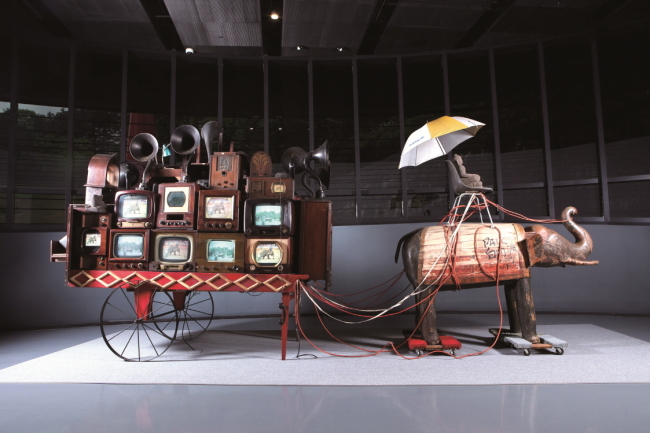Nam June Paik Art Center holds 10th anniversary exhibition
By Shim Woo-hyunPublished : Oct. 14, 2018 - 18:07
An elephant pulls a cart loaded with devices like television sets, radios, telephones and gramophone speakers while a Buddha statue -- sitting on the elephant under an umbrella -- leads the way ahead. These once dominant means of communication are featured in artist Nam June Paik’s work “Elephant Cart.”
It is one of the works on display as part of “Art Commons, Nam June Paik,” which kicked off at the Nam June Paik Art Center on Thursday. The exhibition reintroduces Paik’s artworks, along with the works of contemporary artists.
“The work of Paik suggests the media have become the common property of human kind,” said curator Lee Soo-young of the Nam June Paik Art Center.
It is one of the works on display as part of “Art Commons, Nam June Paik,” which kicked off at the Nam June Paik Art Center on Thursday. The exhibition reintroduces Paik’s artworks, along with the works of contemporary artists.
“The work of Paik suggests the media have become the common property of human kind,” said curator Lee Soo-young of the Nam June Paik Art Center.

The 10th anniversary exhibition is in line with the late artist’s manifesto in many ways. “Art is not private property,” says a quote from Paik’s 1970 piece of writing titled “Global Groove and Video Commune,” in which the artist highlighted his belief that videos could provide a way for the public to be involved in the active exchange of information.
The exhibition starts off with Paik’s work.
One of the artist’s works being presented in the exhibition is “Fluxus Island in Decollage Ocean,” a pseudo map of the European continent that was used to promote the fourth issue of Decollage Ocean -- a magazine by Fluxus, an international artists group that shared anti-commercial aesthetics.
Paik was a member of the group, along with American artists Dick Higgins and Alison Knowles, French artist Ben Vautrier, and German artist Wolf Vostell.
Another artwork in the exhibition reveals Paik’s connection with Jopeph Beuys, an internationally acclaimed German artist who was a Fluxus member. Both Paik and Beuys tried to bring arts into the public domain.
Paik’s “Beuys Vox,” a mixed media work, was dedicated to Beuys after his death. There is also the 60-minute video “Coyote III,” a collaboration between the two artists.
In addition to the pioneering efforts of Paik and Beuys, the exhibition features the works of contemporary artists from Korea and abroad.
Bach Yi-so’s “Today” -- reproduced based on the late artist’s notes -- asks onlookers if an artwork belongs to the artist or to the people who share it. Bach’s work can always be recreated based on the artist’s notes, in an effort to counter the conventional notion that an artwork can only be created by the artist.
“Today” is an installation that features four videos set up on the roof of the art center to create a live streaming projection of the sky that shows the sun’s movement.
Meanwhile, Okin Collective has introduced the documentary video “The More, The Better,” which shares a name with Paik’s seminal work. It questions the elements that make up an artwork, by looking into ongoing discussions about how to restore Paik’s videos that no longer function due to technological issues.
Other works in the exhibition include Heman Chong’s “I Want to Believe,” Jeoung Jae-choul’s ”Another Part of Kraken” and Ahn Kyu-chul’s “There are Things in the World that Cannot be Spoken in Words.”
The exhibition aims to be community oriented, said Suh Jin-suk, director of the museum.
“One of the important topics in the museum circle is about museums of the future. The latest exhibition is the museum’s attempt to find what are the new paradigms, functions and values that contemporary art institutions have to look into.”
In the spirit of artist Paik, the museum is running events alongside the exhibition, with the aim of involving the public.
“Art Commons, Nam June Paik” can be largely divided into three parts, an exhibition of artworks, a symposium featuring lectures by experts and scholars, and the Metamuseum project, which allows the public to propose artworks to the museum.
“We have designated Metamuseum as part of the exhibition, for the public to bring their artwork proposals. There should be clashes between members of the public and experts at the museum because they have to compromise to make artworks presentable.
“As a consequence, the museum has to invest time in inventing new systems. We want to look at the very conflict, in which the museum -- still run by experts -- lends itself and shares property with the public,” Suh said.
By Shim Woo-hyun (ws@heraldcorp.com)







![[KH Explains] How should Korea adjust its trade defenses against Chinese EVs?](http://res.heraldm.com/phpwas/restmb_idxmake.php?idx=644&simg=/content/image/2024/04/15/20240415050562_0.jpg&u=20240415144419)











![[Today’s K-pop] Stray Kids to return soon: report](http://res.heraldm.com/phpwas/restmb_idxmake.php?idx=642&simg=/content/image/2024/04/16/20240416050713_0.jpg&u=)